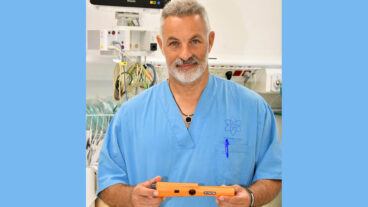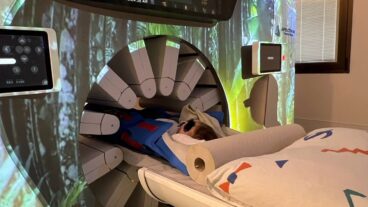TraumaCad allows surgeons to develop a pre-operative surgery plan – including manipulation of orthopedic digital images, reduction of fractures, and application of prosthetic systems.If it hadn’t been for a rock climbing accident, Ze’ev Glozman, the young CEO of Israeli startup Orthocrat would probably still be working in a cellular phone company.
“I was treated in Rambam Hospital (in Haifa),” says the 25-year-old entrepreneur who calls himself “a high school dropout.”
“I spent a lot of time in the orthopedics department. I started thinking and talking to residents about software that can help you do it better.”
That stroke of bad luck for Glozman has turned into good luck for the thousands of Americans who need to undergo orthopedic surgery daily throughout the US.
In March 2003, Glozman founded Orthocrat with his friend, Miron Liram, the chief technology officer and a graduate of the Israeli Defense Forces prestigious Talpiot technology program, and Dr Doron Norman of Rambam Hospital.
The result is TraumaCad, software for orthopedic surgeons. Preoperative planning is recognized as an essential in elective surgery and as an important component in trauma surgery. Surgeons are still use to fracture treatment planning and joint replacement and deformity correction procedures on the basis of two-dimensional (2-D) conventional X-ray images with the tracing procedure.
TraumaCad allows surgeons to develop a pre-operative surgery plan – including manipulation of orthopedic digital images using image processing technique techniques, reduction of fractures, and application of suitable fixation systems or prosthetic systems. The TraumaCad allows greater accuracy and simplicity, when compared to traditional templating techniques commonly used.
According to Glozman, the software was developed “mainly with trauma in mind. We noticed that there is a very developed need for [software for] total joint planning, the replacement of a joint, such as a hip or a knee. This type of procedure is becoming more and more successful and more and more popular.”
While radiology departments have gone digital, the orthopedics department didn’t have a tool for using the computerized information to help them.
TraumaCad is comprised of two modules: JointFactor and TraumaFactor. The first allows the surgeon to sit at his or her desk and find exactly the right implant for the joint from a library of templates of thousands of implants, using the digital viewer to match it to the patient using X-ray or CT scans of the relevant area imported from the Picture Archiving Communication System (PACS) system which is becoming increasingly common in hospitals.
The images are automatically calibrated on screen, making it simple to make the anatomical measurements surgeons need before replacing a joint. TraumaFactor is a similar tool but for the trauma environment, and both modules save a full report on the procedure for the patient’s medical file.
Because hospitals aren
‘t rapid adopters of new technology, Glozman and Liram decided to market their software primarily through distributors. In November 2004, TraumaCad received clearance from the US Food and Drug Administration, which wasn’t strictly necessary for a software tool but “distributors like to know that someone has tested it,” Glozman told ISRAEL21c.
Their hard work traveling around the US to sell their system paid off: they have signed contracts with nine PACS vendors so far, including Web MD, Orex and Dynamic Imaging, and count among their partners medical device giant Smith and Nephew. There are already several installations of the tool in, among other locations, the Harris Methodist H.E.B. Hospital, in Bedford, Texas, and Stony Brook University Hospital in Long Island, New York.
In parallel with marketing TraumaCad, Orthocrat is working on another tool: GrowthFactor. “This is going to be a separate product for pediatric planning and measurement,” says Glozman. “This was developed as an answer to requests from customers.”
GrowthFactor is designed to help pediatric orthopedic surgeons plan surgery to correct deformities and other pediatric orthopedic procedures and the product will be officially launched during the first quarter of 2005.
Orthocrat, which now has six employees and is based in Petah Tikva, received NIS 100,000 ($23,000) funding from the Office of the Chief Scientist of the Israeli Ministry of Industry and Trade and is not looking to raise any funds right now, since the company is already reaping revenue from sales. “We don’t need external funding at the moment,” says Glozman.
There is competition in the market, with the biggest name being OrthoView, a UK-based company whose product also offers pre-operative planning. However, this doesn’t faze Glozman, who believes that Orthocrat has an edge.
“One thing that everyone loves about our product is that it is so easy to use. We spent a lot of time learning the clinical aspects,” he says. He believes that the fact that he and Liram came from a software background and learned about orthopedics gives the product an advantage over those designed by mechanical engineers.
“What a surgeons wants to do with a product is not always what an engineer thinks they want to do,” he said.
What does the future hold for Orthocrat? One direction is towards other markets including Europe and Korea. Technologically-speaking, the company is developing a product for the Tablet PC, a laptop-screen sized computer with a touch screen which the user writes directly on.
“We are prepared to bet on this being a very successful device in the medical market which surgeons could use in the operation room,” says Glozman.
Orthocrat is also publishing some of its developments in scientific journals. “We have a paper coming out in the American Academy of Orthopedic Surgeons. We have become orthopedic experts!” says Glozman proudly. “We have a lot of smart algorithms in the software but surgeons don’t have to know that they are there. They just want to see a picture on a screen. We hope that this will be the missing link between orthopedics and PACS and radiology.”












